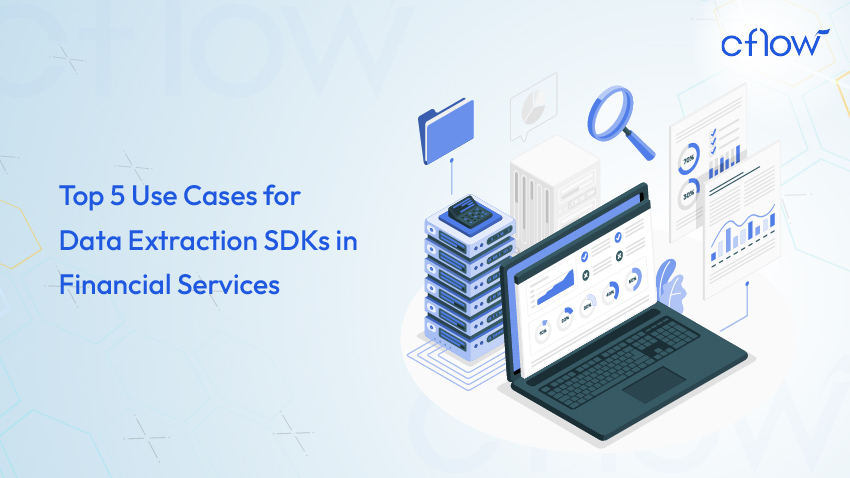Top 5 Use Cases for Data Extraction SDKs in Financial Services

Simplified workflows, enhanced decision-making, and taking control of data are some of the essentials needed by financial institutions to achieve their long-term goals. The fact is that the vast majority of businesses in the financial service sector today are reaping the rewards of AI data extraction SDK tools in their operations.
Whether it’s pulling specific information from financial reports or extracting essential data from patient records, these tools help institutions automate their workflows, which is essentially extracting, processing, and analysing data from various sources.
Such modern tools rely on AI extraction, which means no code workflow builder is needed to accurately extract text, tables, and forms from a myriad of document types.
In this write-up, we’ve discussed the top 5 use cases for data extraction SDKs in financial services so you can understand how these tools can help streamline your business workflows. Read on!
1. Analysis of Financial Statements
The analysis of financial statements in banks and investment firms plays a huge role in assessing the health and performance of such institutions. This assessment is primarily done to help make data-driven investment decisions. Of course, every sector has its most essential documents that help facilitate data-driven investment decisions. In finance, they include:
- Bank statements
- Loan applications
- Mortgage documents
- Transaction records
- Account opening forms
With the help of AI data-extraction software, investment institutions can now capture information from any of the documents mentioned above, regardless of their length. So, if you are in a company with cabinets full of documents, look for a reliable AI-powered data extraction solution to help you unpack and unlock data insights in your workplace.
2. KYC (Know Your Customer) and Compliance in Financial Institutions
KYC is the process of verifying customers’ identities. As a financial institution, this process is mandatory for a seamless operation. You must verify the identity of your customers to detect and prevent fraud and comply with the anti-money laundering regulations of the country you are operating in.
During the KYC process, institutions rely on data-extraction SDKs to categorize, append, and segment data to detect high-risk entities and individuals. It mostly involves data enrichment, which is enhancing, improving, and augmenting raw data by adding relevant information from internal or external sources.
Since the goal of data enrichment is to make data more useful, accurate, and valuable for analysis, manual data enrichment is not recommended. Therefore, you’ll need AI-powered data extraction SDK to accelerate the process, reduce fraud risks, and comply with regulatory requirements.
3. Credit Assessment and Underwriting
Almost every financial institution receives large volumes of loan applications from time to time. Ideally, these applications must be accompanied by supporting documents such as tax returns and bank statements, which contain sensitive information.
So, to facilitate instant loan origination, leading financiers rely on AI’s proprietary technology, which refers to unique artificial intelligence systems, algorithms, or software that are owned and protected by a specific organization or company. The goal is to eliminate the possibility of human errors.
4. Predictive Forecasting and Analysis
As a financial institution grows, there’s a need to predict future trends, behaviors, and outcomes. That’s where predictive forecasting and analysis come into play. It involves using historical data, statistical algorithms, and machine learning techniques to predict future trends, behaviors, or outcomes to help an institution make informed decisions.
You see, AI can extract outdated, unsecured information and convert it into valuable insights that companies in the finance sector can use to predict future trends and outcomes. The aim is to identify opportunities earlier and avoid potential risks.
5. Real-time Document Verification
AI can validate extracted data in real time. Analyzing a real-time data flow goes a long way in facilitating, among other processes, risk management in financial institutions. For instance, financiers rely on bank statements to assess borrowers’ financial health, loan repayment ability, and spending habits.
It also enhances decision-making, such as what offers may or may not appeal to customers.
Last but not least, real-time document verification helps automate compliance tasks like AML checks and smoother onboarding of new clients.
Conclusion
It seems that AI workflows are the future of efficiency. Financial institutions are becoming aware of the potential of advanced AI extraction in enhancing banking operations. It paves the way for efficient workflows, better decision-making, and improved customer experience.
As a business, you can easily integrate a data extraction SDK with existing technology and workflows to quickly scan various types of documents across multiple locations.
So, if you are on the lookout for a reliable data extraction solution, consider factors such as data source compatibility, scalability, security features, regulatory compliance, and ease






